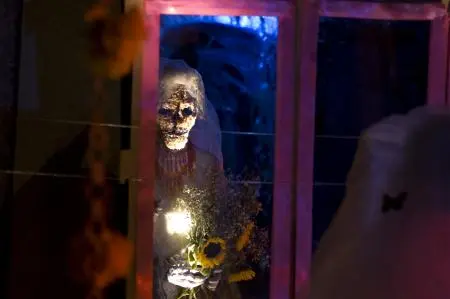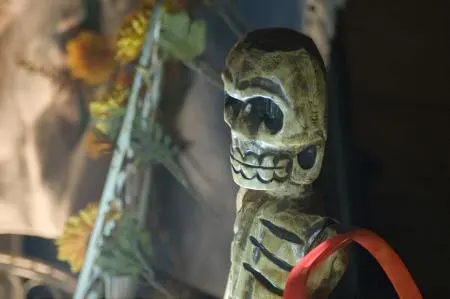LURID: vivid in shocking detail; sensational, horrible in savagery or violence, or, a guide to the merits of the kind of Bad Books you never want your co-workers to know you're reading.
The dark carnival associated with October 31st has rolled around again. It’s the time of year when things usually forbidden are permitted. Monsters walk in suburbia. The chaste let it all hang out in slutty costumes. Kids take candy from strangers. Law-abiding citizens set fire to stuff. And seven out of ten adults in the recession-strapped USA intend to spend, spend, spend, an estimated total of $8 billion this year, which makes Halloween second only to Christmas as a commercial and retail feast.
These days, Halloween is seen by many revelers as no more than a great excuse to bedazzle their dog, paint the town orange and party their socks off on a Wednesday. It’s equal fun for kids and grown-ups across all creeds and colors, the ultimate secular holiday with no religious hang-ups, excessive food intake or family arguments. Let the good times tootsie roll!
Yet there’s a darker side to Halloween that gets neglected amid the modern emphasis on day-glo costumes and candy corn. We seem to have lost sight of the origins of this most persistent of festivals, which dates back more than 3000 years and has survived onslaughts from the Catholic Church and the puritans. We go through the motions, with rituals like face painting, trick or treat, or pumpkin carving, but we have no real concept of the significance of our actions. We’re out there, rollicking in fake breasts and fairy wings, unaware of the sinister forces that may be congregating around us just as they have done for millennia past.
Tonight, therefore, as you don your bunny ears and vampire fangs, it might be worth taking a moment to consider what you are doing, and why. Halloween isn’t just about indulging your taste in horror movies, or screaming your lungs out at a haunted house, or disguising yourself as your least favorite news headline of 2012. Traditionally, it’s the one night of the year when the veil between the living and the dead dissolves away to nothing. Let’s be careful out there.
In pre-Christian Europe, the New Year began once the business of the old one was wrapped up. For Celtic communities, New Year’s Day began at sunset on October 31st, once the harvest and livestock were gathered in for the winter, once communities could live off the stored plenty of summer and hunker down to wait out the long months until spring.
The period between sunset on October 31st and sunrise on November 1st was the time when those who had died during the previous year – with high infant mortality and low life expectancy this could be quite a crowd, even in a small settlement – traveled into the next world. With the door propped open, so to speak, the dead en masse would emerge and walk among the living. It was a good time to ask for their help in making predictions for the months to come as well as paying general respects. This festival was known as Samhain (pronounced “Sow-un”) and many of our current Halloween practices stem from Celtic beliefs.
The dead visit us infrequently so it’s only polite to honor them when they stop by. It’s also a good idea to provide distractions for the evil spirits among their number so that they forget about harming the living. The Celts did this by lighting bonfires – true bone-fires, filled with the bones of animal sacrifices – and constructing shrines laden with fruits and vegetables. They dressed up in the skins and heads of slaughtered animals and told stories via dances. They held feasts, at which they set places for the recently deceased. When the dances and feasts were done, each family took burning embers from the central bone-fire and lit a flame at their dwelling, to be kept burning through the winter months. Before retiring for the night, they left sweetmeats outside their front door to appease any malevolent, dissatisfied spirits still wandering the world.
Sound familiar?
Both the Romans and the Catholic Church attempted to eradicate Samhain as they rolled their belief systems through Europe. The festival was unpopular with conquering forces for obvious reasons: it involved bloodshed (not all the sacrifices were animal) and provided an opportunity for Druids to influence the mood of the local population with prophecies regarding the year to come.
Samhain coincided with the day the Romans honored Pomona, their Goddess of Fruits and Gardens, whose symbol was the apple. The occupiers attempted to fold the indigenous festival into their harvest celebrations, as well as combining it with some of the rituals of their own late-February festival of the dead, the Feralia. Ovid describes the observances thus:
…the grave must be honored. Appease your fathers' Spirits, and bring little gifts to the tombs you built. Their shades ask little, piety they prefer to costly offerings: no greedy deities haunt the Stygian depths. A tile wreathed round with garlands offered is enough, a scattering of meal, and a few grains of salt, and bread soaked in wine, and loose violets: Set them on a brick left in the middle of the path... and hide the gods, closing those revealing temple doors, let the altars be free of incense, the hearths without fire. Now ghostly spirits and the entombed dead wander, now the shadow feeds on the nourishment that's offered. …This day they call the Feralia because they bear offerings to the dead: the last day to propitiate the shades.
- Ovid, Fasti II

The Romans failed to quell the pagan urges of Samhain, and succeeded only in adding their customs into the mix, in the form of apple-bobbing and decorating tombs. The Catholic Church tried a lot harder to strip Samhain from its roots and claim the otherworldly energy for itself. Early in the 7th century AD, Pope Boniface IV declared November 1st “All Saints’ Day”, a festival that would commemorate the hundreds of canonized individuals who hadn’t been allocated their own feast. Two centuries later, the Byzantine Emperor, Leo VI ("the Wise") introduced All Souls’ Day on November 2nd. Officially known as The Commemoration of All the Faithful Departed, the day was set aside for remembering all the baptized dead, martyr or civilian. All Saints’ Day was also known as All Hallows, hence All Hallows’ Eve. By some strange coincidence, the Holy See sanctioned bonfires, dressing up (as saints, angels or demons), parades, feasts, and ornamenting graveyards as appropriate observances of the Catholic faith. The end of October/beginning of November, referred to as Hallowmas by the church, reverted to what it always had been – a celebration of the dead.
Since then, Halloween has mutated along with Western Civilization. It survived the trip to the New World where it became a peculiarly American tradition. Colonial incomers brought their All Hallows’ Eve customs with them and blended them into the local festivities. These customs included “guising” from Scotland, where children sing or say a prayer for the dead in return for cake. The Irish were used to carving their jack-o-lanterns (lit to commemorate souls in purgatory) out of flinty turnips, so they embraced the opportunity for innovation presented by soft pumpkin flesh. Immigrants from Catholic Eastern and Southern Europe re-introduced their Protestant neighbors to the cemeterial candles, flowers and feasting associated with their Dia De Los Muertos. Everyone told each other their favorite ghost stories. The nineteenth century obsession with spiritualism led to a revival in ancient traditions of divination – what better time for a séance than on the night of the living dead?
Before it all got too witchy, somebody thought of the children. The early twentieth century saw a shift away from adult costumes and parties, towards community-based games, party food and fun craft activities for kids. This is Halloween as we know it today, a block party peopled by sheeted ghosts, miniature pirates and nylon princesses, with the focus on treats and giggles as opposed to tricks. Everyone’s welcome, no belief system required, just a willingness to don a disguise and party hard. Evil spirits and the recently deceased are acknowledged only as cartoons and vodka jelly molds. Death, where is thy sting? Probably collapsed in the corner from an epic sugar high.

Yet, despite all attempts to sanitize the festival, it seems we can’t quite manage to remove its teeth. There’s something dark and brooding in the air this time of year, something waiting for darkness to fall. Across the USA, this manifests in annual scare headlines about the ‘Halloween Poisoner’, the apocryphal child-killer stuffing strychnine into fun-size Snickers and loading apples with razor blades (FACT: child fatalities at Halloween tend to be victims of their friends and family, like unfortunate 8 year-old Timothy Clark O’Bryan, poisoned by his father, Ronald ‘The Candyman’, for a $20,000 life insurance payout). It manifests in ‘Mischief Night’, which is actually October 30, but has become identified with Halloween, when teenagers rampage through neighborhoods pulling pranks, TPing properties, and in Ontario, tossing rotten cabbages about. It manifests in Detroit as ‘Devils’ Night’, a citywide vandalism and arson spree that reached a terrifying peak in the 1980s, with 800 fires set overnight. It manifests in the increasing sexualization of Halloween costumes, for both adults and kids. When the ancient Celts devoted the night to entertaining and placating evil spirits so that they and their families came to no harm, they might have been on point.
Anyone who has read Neil Gaiman’s American Gods knows that we carry ancient divinities and their demands forward into history with us, even if we fail to placate them through tribute, even if our indifference reduces them to running a funeral parlor in Cairo, Illinois. Our supposedly secular culture sits on layer upon layer of religious belief. Halloween represents the one night of the year when we allow some of those deeper layers to surface. Just as it always has done.
Thanks to electric light, central heating and thermal underwear, we don’t fear the coming of winter as we once did. Modern medicine and nutrition keep the cruelties of death at bay. Halloween has outlived its original purpose – which is why, superficially, it’s been downgraded to “International Orange And Black Day”. But we can’t seem to let its intrinsic meaning go. For more than three thousand years we’ve been going through the same motions, dancing the same dance, wearing the same masks, offering up the same cakes and fruits. Deep down, whether we articulate them or not, we have the same intentions, the same need to acknowledge there aren’t so many differences between the living and the dead, and that, once a year or so, we should all hang out and party.
Tonight, once your identity is hidden safely behind a mask and a jack-o-lantern casts his protective glow around your home, forget the rampant commercialism and enjoy your masquerade with the spirits. Carouse and cavort all you can because you have no way of knowing, next time October 31st rolls around, which side of the veil your shade will fall.
How will you celebrate Halloween 2012? A Samhain ritual with your local Wicca group? Conventional trick-or-treating? A Day of The Dead shindig at the nearest boneyard? A costume ball? Jäger shots? Share your plans in the comments below.

About the author
Karina Wilson is a British writer based in Los Angeles. As a screenwriter and story consultant she tends to specialize in horror movies and romcoms (it's all genre, right?) but has also made her mark on countless, diverse feature films over the past decade, from indies to the A-list. She is currently polishing off her first novel, Exeme, and you can read more about that endeavor here .







